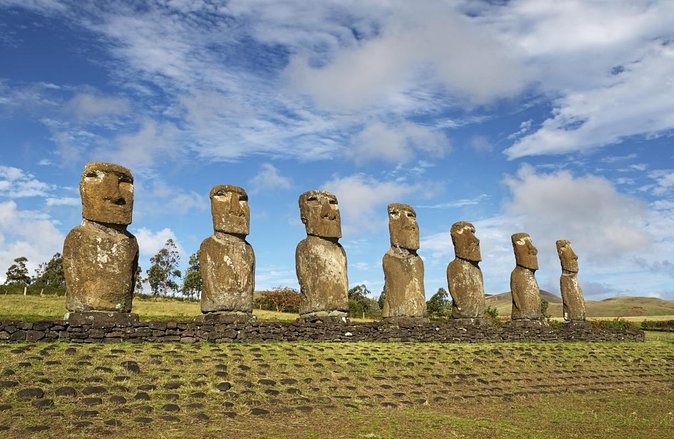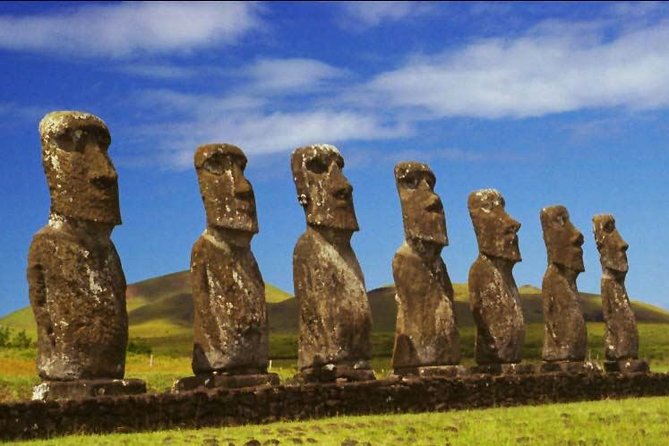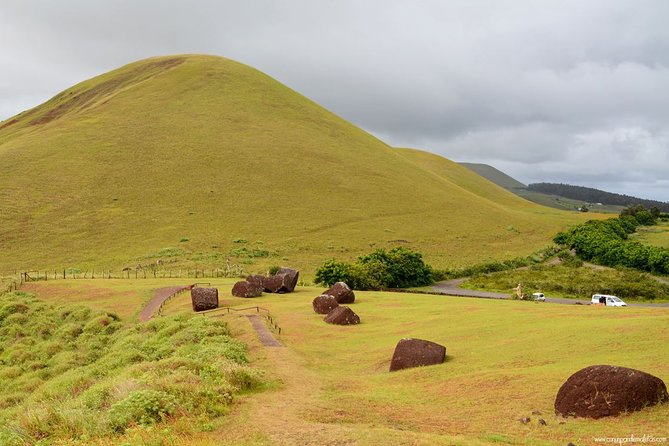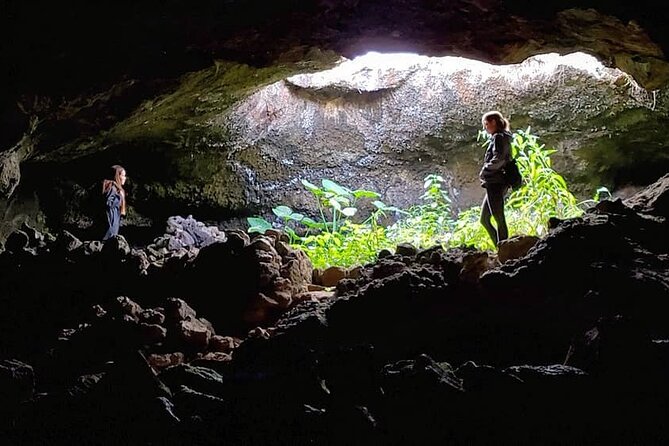Ahu Akivi, home to The Seven Moais on Easter Island, boasts a unique feature that sets it apart from other moai sites – it is the only one where the statues face the ocean. This intriguing alignment has puzzled researchers for decades, sparking debates about its possible significance and purpose.
Exploring the mysteries behind this enigmatic choice of orientation unveils a deeper layer of complexity to the history and culture of Easter Island, inviting curious minds to explore the secrets hidden within the stone giants of Ahu Akivi.
Good To Know

- Ahu Akivi features seven 14-foot tall moais representing original explorers sent by King Hotu Matu’a.
- The moais are strategically aligned to face the ocean, potentially guiding seafaring travelers.
- Advanced astronomical knowledge is showcased through the precise alignment of the moais with celestial events.
- Preservation efforts face challenges like erosion and vandalism, emphasizing the need for conservation initiatives.
Location and Significance
Located on Easter Island, Ahu Akivi is a renowned archaeological site featuring seven striking moais with significant historical and cultural relevance. These moais, carved from compressed volcanic ash, stand at about 14 feet tall and are believed to represent seven explorers sent by the king to scout the island.
What makes Ahu Akivi unique is that unlike other moai sites on the island, these statues face the ocean instead of inland, possibly serving as guides for seafaring travelers. The location of Ahu Akivi holds great importance in the history of Easter Island, offering insight into the island’s past civilization and the beliefs of its inhabitants.
This site provides visitors with a fascinating glimpse into the rich cultural heritage of Easter Island.
Find more activities and experiences we've covered in Easter Island.
History and Mythology

History and mythology intertwine at Ahu Akivi, weaving tales of ancient explorers and mystical beliefs that continue to captivate visitors to this archaeological wonder on Easter Island. The site is steeped in fascinating lore, blending historical events with mythical narratives that have been passed down through generations.
Some of the key points to consider about the history and mythology of Ahu Akivi include:
- The seven moais at Ahu Akivi are believed to represent the seven original explorers sent by King Hotu Matu’a to scout the island.
- According to local legend, these moais are positioned facing the ocean to help guide the spirits of the departed explorers back to their homeland.
- The alignment of the moais is thought to have astronomical significance, with some theories suggesting a connection to celestial events.
- Various myths and stories surround Ahu Akivi, adding to the mystique and allure of this sacred site.
Construction and Alignment

The ancient construction techniques utilized in erecting the seven moais at Ahu Akivi reveal a remarkable precision in their alignment, hinting at a deeper purpose behind their placement on Easter Island. The moais were strategically positioned facing the sunset during the equinoxes, suggesting a celestial significance in their construction. The alignment of the statues also points towards a sophisticated understanding of astronomical events by the Rapa Nui people. This careful arrangement showcases the advanced knowledge and skill of the ancient islanders in creating structures that not only honored their ancestors but also served as markers for important celestial occurrences.
| Moai Alignment | Celestial Significance |
|---|---|
| Equinoxes | Sunset positioning |
| Astronomical Events | Advanced knowledge |
Symbolism and Representation
Symbolism and representation intertwine intricately in the seven moais standing proudly at Ahu Akivi, offering a window into the spiritual beliefs and cultural heritage of the Rapa Nui people on Easter Island.
- The moais are believed to represent ancestral chiefs, embodying protection and guidance for the community.
- Each moai’s distinct facial features may symbolize individual lineage and unique characteristics of the ancestors they depict.
- The positioning of the moais facing towards the ocean suggests a connection to the sea, essential for sustenance and survival.
- The size and grandeur of the moais reflect the status and importance of the ancestors they represent, showcasing their significance in Rapa Nui society.
Preservation Efforts and Challenges
Preservation efforts and challenges surrounding the seven moais at Ahu Akivi on Easter Island highlight the ongoing commitment required to safeguard these ancient cultural treasures. The moais, with their historical and archaeological significance, face various threats such as erosion, weathering, and potential vandalism.
Efforts to preserve these statues include ongoing monitoring, restoration work, and research to understand the best conservation practices. Challenges arise due to limited resources, the remote location of Easter Island, and the delicate nature of the moais themselves. Balancing tourism with preservation efforts is also a key challenge, as increased visitor numbers can impact the site.
Collaborative initiatives involving local communities, experts, and authorities are essential to ensure the long-term protection of Ahu Akivi’s iconic moais.
Visitor Experience and Accessibility
Visitors to Ahu Akivi on Easter Island can enjoy the ancient culture of the moais while exploring the site’s accessibility features. The site offers a range of experiences to cater to different needs:
- Paved pathways leading to the moais for easy navigation.
- Informational signs in multiple languages for educational purposes.
- Benches strategically placed for visitors to rest and take in the surroundings.
- Visitor center with staff available to provide assistance and answer questions.
Guided Tours and Recommendations

When planning a visit to Ahu Akivi on Easter Island, travelers are encouraged to consider joining a guided tour for a comprehensive exploration of the site’s historical significance and unique features. The guided tour to Ahu Akivi typically includes a professional guide, transportation, and the entrance fee. Here is a breakdown of what to expect on the guided tour:
| Inclusions | Exclusions | Additional Info |
|---|---|---|
| Professional Guide | Extras not in itinerary | Confirmation upon booking |
| Transfer | Gratuities | Not wheelchair accessible |
| Entrance Fee | Bring comfortable clothes |
Joining a guided tour ensures a hassle-free experience and allows visitors to delve deeper into the mysteries of Ahu Akivi with expert insights.
Travel Tips and Practical Information

For optimal exploration and enjoyment of Ahu Akivi on Easter Island, travelers are advised to familiarize themselves with essential travel tips and practical information before embarking on their visit. Here are some key points to keep in mind:
- Meeting Point: Hanga Roa, Easter Island, Valparaíso, Chile
- Start Time: 02:30 pm
- Additional Info: Confirmation upon booking, Not wheelchair accessible, Bring comfortable clothes, Sunglasses, Sunscreen
- Cancellation Policy: Full refund if canceled 24 hours in advance
Frequently Asked Questions
Can Visitors Touch or Climb on the Moai Statues at Ahu Akivi?
Visitors should not touch or climb on the Moai statues at Ahu Akivi. Respecting these sacred artifacts preserves their cultural significance and helps ensure their preservation for future generations. Admire them from a respectful distance.
Are There Any Restrictions on Photography at the Site?
Photography restrictions may apply at the site. Visitors should inquire about any specific rules regarding photography before capturing images. It’s essential to respect any guidelines in place to preserve the historical and cultural significance of the location.
Are There Restroom Facilities Available Near Ahu Akivi?
Restroom facilities are available near Ahu Akivi. Visitors can easily access these conveniences to ensure a comfortable experience while exploring the site. It’s recommended to utilize these facilities during the visit for convenience.
Is There a Gift Shop or Souvenir Store at the Site?
Yes, there is a gift shop at the site. Visitors can purchase souvenirs and gifts to remember their experience at Ahu Akivi. The shop offers a variety of items for travelers seeking mementos of their visit.
Are There Any Nearby Dining Options for Visitors to Grab a Meal or Snack After the Tour?
After the tour, visitors can find nearby dining options to grab a meal or snack. Various restaurants and cafes in the area offer a range of cuisine choices, allowing travelers to relax and refuel after exploring Ahu Akivi and its surroundings.
The Sum Up
To sum it up, a visit to Ahu Akivi, The Seven Moais on Easter Island, promises a mesmerizing journey through history and culture.
Despite potential challenges, the experience of standing before these enigmatic statues is truly unforgettable.
With guided tours available, travelers can explore the mysteries of this ancient site and appreciate its significance in the story of Easter Island.
Prepare for a unique adventure filled with wonder and discovery at Ahu Akivi.
More Tour Reviews in Easter Island
Looking for something different? Other Easter Island activities we've written about
- 13 Best Tours In Easter Island
- 9 Best Full-Day Tours In Easter Island
- Best Guided Tours In Easter Island
- Best Guided Tours In Easter Island
- Easter Island: Moai Full Day Private Tour
- Snorkeling in the Motus of Easter Island
- Baptism Diving in Easter Island
- Full Day Tour to the Emblematic Sites in Rapa Nui
- Discover the Mystical Easter Island and Its Famous Gigantic Stone Statues
- 4-Day Adventure Tour in Easter Island
- Easter Island Moai Dining Experience
- Kings Scouts Guardians of Paradise: Half Day
